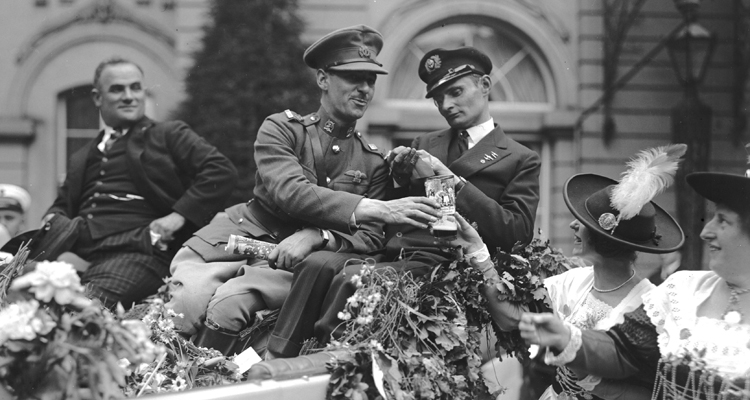“There’s a fish in the sky!” yelled an incredulous Antoine Letemplier. The 11-year-old son of the lighthouse keeper on ice-covered Greenly Island, Antoine had been at the kitchen window, watching the sledge-dogs romping in the snow outside, when suddenly his attention was distracted by an unfamiliar object just below the clouds. Then came a strange roaring sound. Wide-eyed, Antoine charged out the door ahead of a posse of bewildered siblings and adults.
The silver monoplane had appeared out of nowhere, descending like a wraith from the overcast before circling low over the island. After releasing a smoke canister to check on wind direction, it turned directly into the easterly gale and lined up on the frozen reservoir below.
In such perilous conditions, there could be no second chance to land. Slowed by the wind, the plane made a perfect three-point landing on what from the air had seemed like a solid surface. But the spring thaw had already begun, and moments later the plane plunged through the ice, tipping forward violently on its nose.
It was 6:08 p.m. GMT (1:08 EST) on April 13, 1928. The aircraft was only slightly damaged, and its three crewmen were shaken and bruised but triumphant. After 36 hours and 30 minutes in the air, having flown 3,288 miles, they were safely back on terra firma. No matter that they had landed in eastern Quebec, more than 1,000 miles from their intended destination, New York City. They had made history. Flying the Junkers W33 D1167 Bremen, German pilot Hermann Köhl, flight sponsor Baron Ehrenfried Günther von Hünefeld and Irish copilot James Fitzmaurice had completed the first east-to-west transatlantic crossing by airplane (the British airship R34 had made the first east-west flight in 1919).
But how did an Irishman and former British officer come to occupy the copilot’s seat on a German transatlantic attempt, one that had defiantly flaunted the old imperial German flag before taking off from Dublin? Like so many things in this unsettled era, the answer lay in the 1914-18 war and the transformation of a young draper’s assistant first into a soldier, then into a Royal Air Force pilot and finally into the commander of a fledgling air service.
James Christopher Fitzmaurice, usually known as “Fitz,” was born in Dublin on January 6, 1898, but spent most of his childhood in Maryborough (now Portlaise). There in 1912 the Aldritt brothers, local garage owners, constructed a monoplane that briefly became airborne, an event widely credited with inspiring the young Fitz’s interest in aviation.
A poor student, he left school at 16 to work at a Waterford drapery firm, though not for long. World War I was raging, and Fitz was eager to join up. Enlisting underage in the 17th Lancers in 1915, Fitz was soon transferred to an infantry battalion in the trenches. He fought with distinction in the Battle of the Somme and was wounded. Commissioned in November 1917, and seeking to escape the mud and carnage, he applied for a transfer to the Royal Flying Corps. But it was not until June 1918 that Fitz finally made it to flying school at Eastbourne. He then joined the newly formed Royal Air Force, which on April 1 had absorbed the RFC and the Royal Naval Air Service. He was posted to France on November 11, 1918, Armistice Day, too late to experience the ultimate test of aerial combat. Two months later he married a former Women’s RAF noncom, Violet Clarke.
Fitz went on to serve with the occupation forces in Germany, flying the mail in de Havilland D.H.9As with No. 110 Squadron. In May 1919, he made the first night mail flight between Eastbourne and Boulogne. He was also considered for a flight from Cairo to Cape Town that never materialized. By this time he had adopted the clipped speech of the British officer, which he retained throughout his life, probably to his later detriment back in Ireland.
Demobilized in December 1919, Fitz spent 18 unhappy months as an insurance salesman before rejoining the RAF on a short service commission in May 1921. He was posted to No. 25 Squadron, flying Sopwith Snipe fighters. Notified soon after of an imminent transfer to India, Fitz faced a dilemma. He was a married man and the father of a baby daughter, in a service that frowned on marriage before the age of 30 and where overseas tours for junior officers were often unaccompanied.
Seeing no alternative, he resigned from the RAF in August 1921 and returned to an Ireland then on the verge of throwing off British rule and becoming the Irish Free State through the treaty of December 1921.
The next year Fitz became a lieutenant in the newly formed Irish Army Air Service (later Air Corps) at Baldonnel, near Dublin. Ireland was then involved in a vicious civil war, as Michael Collins’ Free State Army skirmished with anti-treaty republicans. Apart from training pilots, Fitz flew recon and light bombing patrols in Bristol Fighters and D.H.9s, often drawing fire from the “irregulars.” Once, having landed in hostile territory with a disabled engine, he evaded capture and returned to base in full flying gear astride a farm horse. Given command of Fermoy aerodrome in Cork in September 1922, he was dropping amnesty leaflets over Killarney when his aircraft was damaged by rebel fire. After a successful forced landing he found a car to return him to Fermoy, but then drove slap into a republican ambush from which he was lucky to escape alive. Fitz was promoted to captain in May 1923, but when the Irish civil war ended in an edgy peace, the air corps gradually languished through lack of funding. Seeking other outlets, Fitz turned to the challenge of transatlantic flight. John Alcock and Arthur Whitten Brown had already made the first direct west-to-east airplane crossing in 1919, in a Vickers Vimy. But a still greater challenge remained, an east-to-west airplane flight against prevailing winds. Fitz approached the Irish government with a proposal to use the air corps’ sole Martinsyde Type A Mk. II for such a venture, but funds were scarce, and his plan was rejected.
By October 1926, Fitzmaurice had been promoted to commandant and acting commanding officer of the air corps. Still he craved greater opportunities and broader horizons than those offered by Ireland’s diminishing air arm. His chance came in the summer of 1927, when Imperial Airways pilot Robert “All-Weather Mac” McIntosh asked Fitz to copilot the Fokker VIIa Princess Xenia on an east-west transatlantic attempt from Baldonnel to New York.
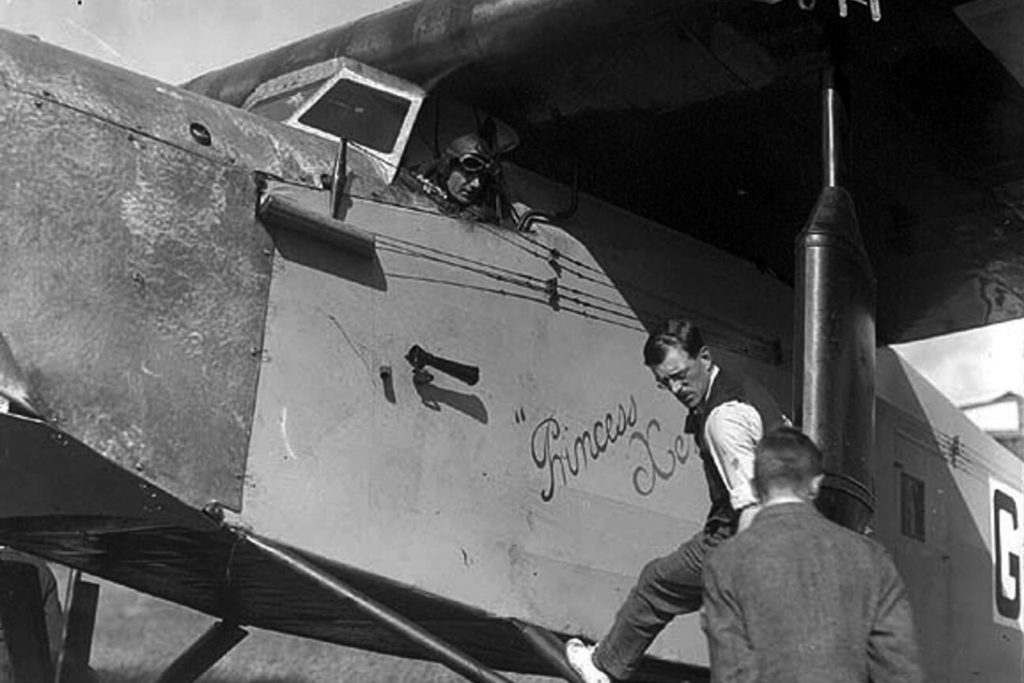
McIntosh had planned to make the flight with Lt. Col. F.F. Minchin, also of Imperial Airways, but Minchin had backed out on the venture after receiving a better offer from Princess Ann Löwenstein Wertheim to pilot her Fokker VIIa St. Raphael on an east-west attempt, with Leslie Hamilton as copilot. They took off from Upavon on August 31, 1927, and after a sighting in the mid-Atlantic, were never seen again.
The disappearance of St. Raphael and the loss soon after of the Fokker VIIa Old Glory, flown by Lloyd Bertaud and James de Witt, and the Stinson Detroiter Sir John Carling, piloted by Terence Tully and James Medcalf, turned public and media opinion against “these foolhardy flights.” This led to calls for McIntosh to abandon his attempt. He responded in typically robust fashion by making several long flights around Ireland with Fitz, working out fuel consumption and optimum speeds at various heights and allowing his copilot to get the feel of the big Fokker. Eventually they picked a day of which McIntosh gloomily recorded, “The weather was possible although not desirable, but it would have to do.”
Loaded with 740 gallons of fuel, Princess Xenia took off from Baldonnel at 1:31 p.m. on September 16, 1927, headed for New York. The weather over Galway Bay was dull and gray, with increasing winds and clouds down to 300 feet. Flying just above the waves, the crew quickly encountered mist, rain and severe turbulence. Three hours later the pilots were dog-tired from wrestling with the controls. Seeking calmer air, they climbed the Fokker to 1,000 feet, but the weather was still foul. Two more wearying hours followed, of which McIntosh later wrote, “By now the thing was a nightmare and virtually out of control.” He looked inquiringly at Fitzmaurice, who shouted, “It’s hopeless, Mac, turn back.” They would try again when the weather improved. Setting a course for Baldonnel, they found the Fokker more manageable with the gale behind them. They flew low through mist, remaining within sight of the sea.
Princess Xenia had been flying with 40 percent overload. At 7 p.m., needing a lighter load for a hazardous night landing, McIntosh sent Fitzmaurice aft to jettison the fuel in the No. 4 tank. To do so, Fitz had to disconnect the fuel pipe and connect a flexible hose to drain the gas through a vent in the cabin floor. By that time the Fokker was only 50 feet above the water. Seeing surf ahead, McIntosh banked right to follow the coastline. He called out to Fitz, “Is that bloody tank empty yet?” A long silence was broken by Fitz’s frightened voice answering, “God, I’m blind!”
Having found a kink in the pipe, Fitzmaurice had lifted his goggles to see better, whereupon the pipe had untwisted and sent a jet of fuel straight into his eyes. When the now thoroughly alarmed McIntosh turned around to shine a flashlight on his copilot, he saw Fitz rolling in agony on a cabin floor awash with gas. There was no question now of heading for Dublin; McIntosh needed to land the Fokker immediately to tend to Fitz. He began scanning the coastline for a suitable stretch of sand. Luck was with them for once, and soon Princess Xenia touched down on Ballybunnion Beach. Fetching seawater in a cup, McIntosh bathed Fitz’s eyes until the copilot’s vision gradually returned. Locals helped push the plane away from the incoming tide.
After a night in a nearby hotel and the arrival of a fuel truck to drain all but one of the Fokker’s tanks, the pair flew back to Baldonnel, determined to try again once the weather improved. But fate was seemingly against them. Sand had penetrated the air intakes of the Bristol Jupiter engine, and it needed to be completely overhauled, a job that would require several weeks. This depressing news came just as a high pressure system arrived over the Atlantic, offering unlimited visibility and a northeasterly tail wind.
McIntosh’s transatlantic hopes were over. But in March 1928, Fitz got an improbable second chance when Baron von Hünefeld invited him to copilot his Junkers W33 Bremen on its second attempt to make the first east-to-west transatlantic flight, from Baldonnel to New York. Bremen’s previous attempt had been from Dessau on August 14, 1927, when it turned back after many hours of being battered by headwinds and encountering impenetrable fog. The pilot on that flight was Hermann Köhl, a World War I Gotha pilot who had led bombing raids against England before embarking on a postwar career with Lufthansa, with Friedrich Loose as copilot. Loose had then left the team to fly with Rolf Starke and Viennese actress Lilly Dillenz in an unsuccessful October 1927 east-west attempt in a Junkers G24 seaplane. Köhl stayed on with Bremen despite Lufthansa’s bitter disapproval.
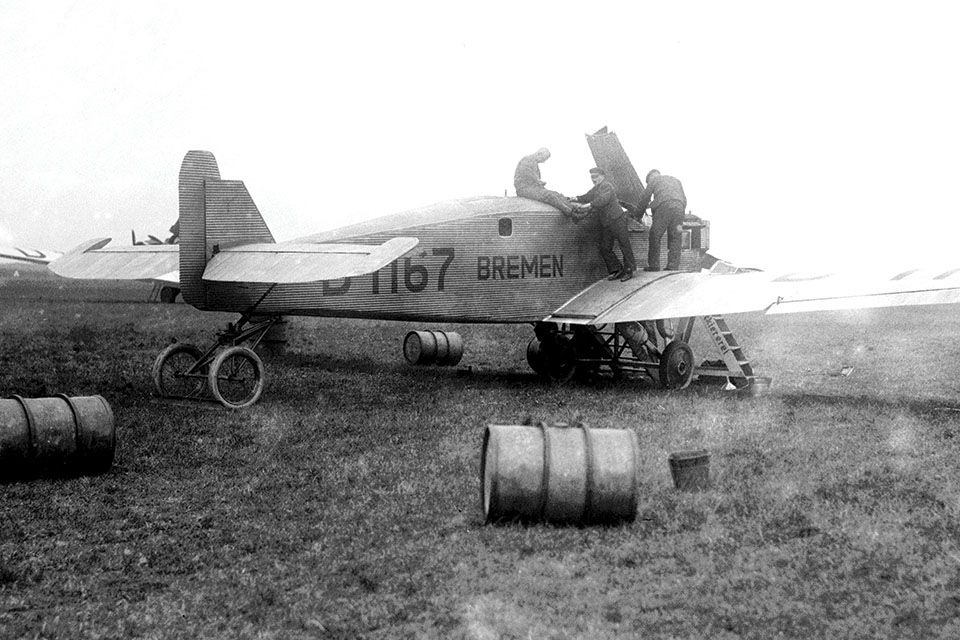
Bremen differed in several ways from the standard W33 freighter. Its undercarriage had been reinforced to withstand the weight of 500 gallons of fuel, the bulk of which was carried in four aluminum tanks inside the normal freight compartment. The fuel load was estimated to be sufficient for more than 38 hours in the air at the plane’s cruising speed of 93 mph. During takeoff a tail-dolly would initially reduce the load on the greased tail-skid. The compression ratio of the Junkers L5 water-cooled 6-cylinder engine had been increased to provide extra horsepower, and a device was installed to allow the crew to top off the engine coolant from the cockpit. For greater lateral stability, special upward-tilting wingtips were installed. No radio was carried because of weight concerns. With its slab sides of corrugated duralumin and thick cantilever wing, Bremen was no beauty, but it was functional and very tough. To prevent icing, a coating of paraffin had been applied.
The decision to start Bremen’s second transatlantic attempt from Baldonnel, rather than Germany, was based partly on the shorter distance involved. But another major factor was the disapproving attitude of the German press and officials toward further transatlantic flight attempts. This outlook hardened when Imperial Airways pilot Ray Hinchliffe was lost on March 13, 1928, during an east-west attempt in the Stinson Detroiter Endeavour with heiress Elsie McKay. Hinchliffe had been concerned that Bremen might get away first.
There was also a political element to Fitzmaurice’s selection as co-pilot. The choice would obviously please the Irish government and, von Hünefeld reasoned, there could be no disadvantage to arriving in New York with a handsome Irishman in the crew.
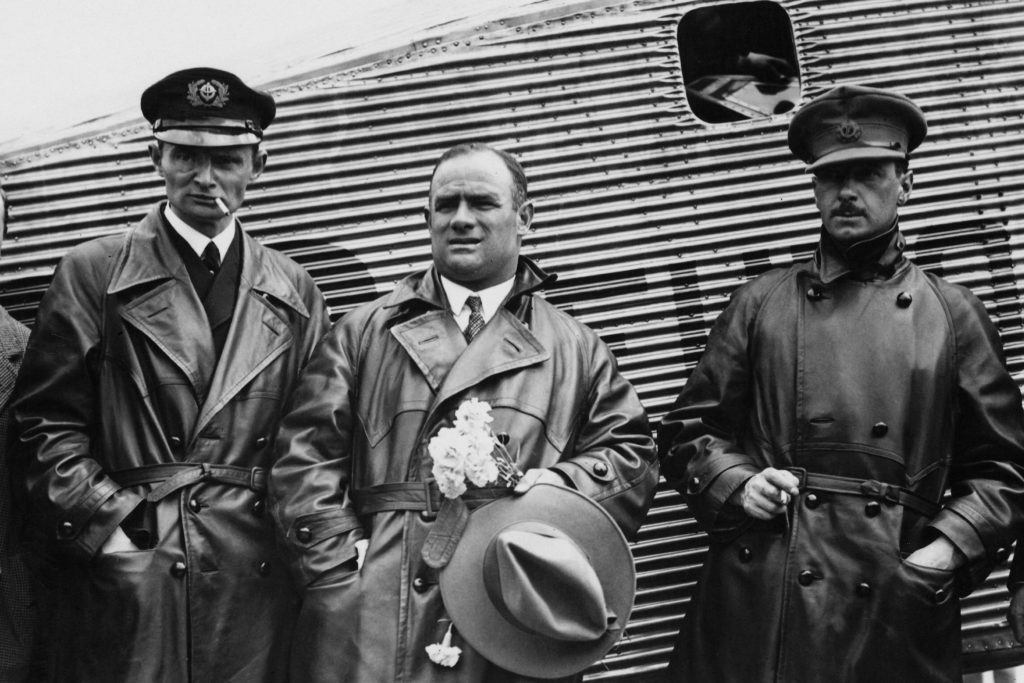
After days of frustration waiting for the weather to improve, Köhl, von Hünefeld and Fitzmaurice finally boarded the heavily laden Bremen early on April 12, 1928. The flags of imperial Germany and Ireland fluttered cheerily from the cockpit. Sporting a jaunty yachting cap, the monocled baron would have no role in flying the aircraft. His job was to pass food and drink to the pilots from his compartment at the rear, aft of the massive cabin fuel tanks.
Because of language difficulties, the pilots had worked out a far-from-ideal system of signs, handshakes and notes. Having used this method to complete their cockpit checks, Germans and Irishman then bowed formally to each other. Without a significant headwind, the maximum-weight takeoff roll was bound to be long. After opening the throttle, Köhl was concentrating hard on keeping the unwieldy Bremen straight as the speed built up—when Fitzmaurice suddenly hollered “Sheep!” and yanked back on the control column. Later he recounted, “We cleared the sheep and sank back on the ground with a sickening thud.” Miraculously unfazed, Köhl regained control and at 5:38 a.m. GMT gently eased the Junkers into the air, heading west. Once past Galway and out over the Atlantic, flying at 1,500 feet, he handed the controls over to Fitzmaurice.
For the first 10 hours, the weather was almost perfect. Light clouds, limitless visibility and an ocean below as docile as a lake allowed the pilots to relax. Taking three-hour stretches at the controls, they stared contentedly at the far horizon until a cough and backfire from the engine reminded them to adjust the mixture control. Periodically they dropped a smoke canister to check on wind direction. At 4:20 p.m. they crossed the 30th meridian, having covered nearly 950 miles in less than 11 hours. Their last drift reading was at 5:50.
This halcyon progress along their great-circle route to New York continued until 9 p.m., when a strong wind from the northwest led to a course correction of 15 degrees to the north. Their estimated dead reckoning position was 40 degrees longitude, more than halfway across and within 1,000 miles of Newfoundland—cause for some mild self-congratulation. But when they encountered a massive fog bank during the final hours of daylight, elation soon turned to anxiety. The second and most critical phase of the flight had just begun.
In Europe, Köhl had spent long hours mastering the art of “fogflying,” an investment that was about to pay handsome dividends. Intimately familiar with Bremen’s handling characteristics, he now assumed the main burden of piloting, with Fitz’s role centered on increased cockpit vigilance and fuel monitoring. Both pilots had an airspeed dial, turn and bank indicator and magnetic compass, but Köhl also had a climb and descent indicator and the left-right indicator of an Askadia remote compass.
Flying close to the ocean again in the fading light, they were soon in the midst of a raging storm. The rain sluiced down, and there was hardly room to maneuver beneath the low clouds. Climbing back up to 2,000 feet brought some relief, but the gale still raged while the bowl compass swung erratically under fearsome gusts that sometimes threw them off course by 30 degrees.
To add to their worries, Fitz spotted oil on the cockpit floor. An anxious glance at the glass tube from the oil reserve tank glass indicated an apparent and potentially disastrous malfunction in the transfer process. Closer inspection by wavering flashlight revealed a film of oil in several vital areas. Although Fitz failed to locate the leak, he assumed the worst. Back in his seat, he handed Köhl a note urging that, because of the seepage, they should alter course to the northwest to reach land as soon as possible. Only later, well after this further course correction, did Köhl realize they had reacted to a false alarm—the oil gauge was a measure of flow from the reserve supply and not of the amount of oil in the tank. The oil seen by Fitz was a small seepage, over many hours, from the tachometer cable.
Inevitably the confusion added to the course errors that were building up during the stressful conditions of instrument flight, with beam winds carrying the slow-flying monoplane inexorably northward, well away from its intended track and farther from New York with every mile flown. These errors were compounded by an electrical failure that forced the pilots to read the instruments by flashlight and a disruptive midnight coffee break during which Bremen somehow got turned completely around. Disoriented and unable to see Polaris, they flew blindly on in the general direction of the North Pole!
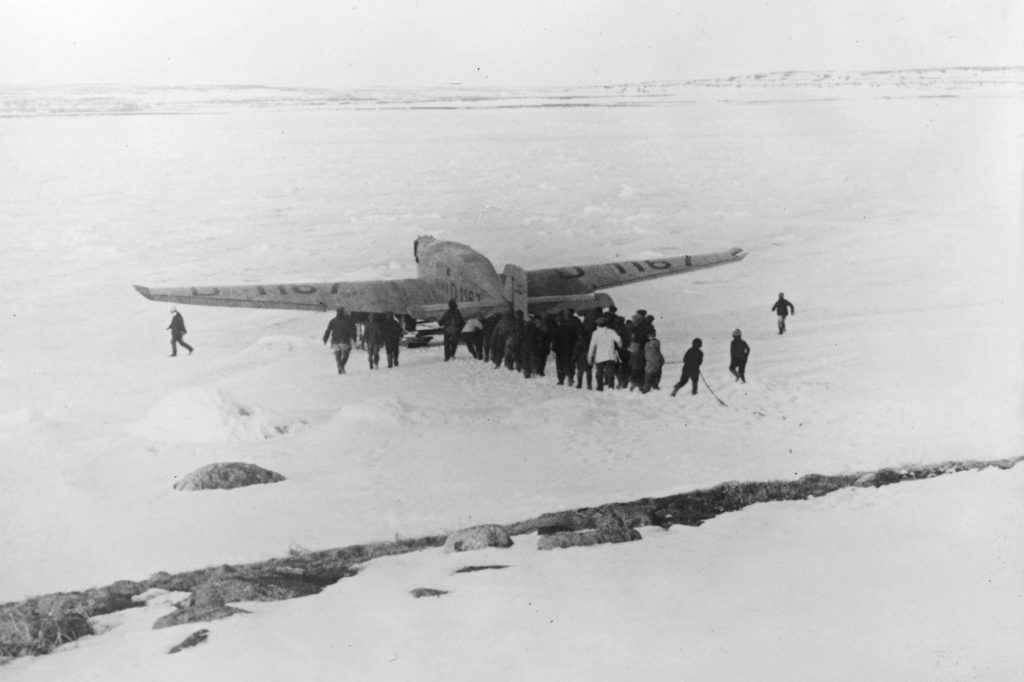
Emerging from fog and clouds around 7 a.m. GMT on April 13, the exhausted pilots were shocked to discover a course error of some 40 degrees. Turning onto a southwesterly heading by Polaris, they eventually identified the inhospitable landscape below as Labrador. Seeing no signs of human habitation, they flew on over the Torngat Mountains, then low along the George River to the North West River. They had been in the air for well over 30 hours and were becoming seriously concerned about their fuel. A long hour later, heading south and searching desperately for a settlement to land near, they spotted what Fitz described as “a large ship frozen in the ice.” Minutes later Bremen made its icy touchdown on Greenly Island in the Gulf of St. Lawrence, where Antoine Letemplier’s father was the lighthouse keeper.
The subsequent Bremen recovery operation was a minor epic in itself, involving many of the great names of aviation: Bernt Balchen, Clarence Chamberlin, Charles Lindbergh and Duke Schiller among them. It also led indirectly to the death from pneumonia of the great Floyd Bennett. After Bremen’s crew had been flown out, the repaired plane was moved to the Canadian mainland. Fred Melchior of Junkers subsequently attempted to fly it to New York but crashed on takeoff, inflicting more damage than had been sustained during the reservoir landing. The dismantled Bremen was then shipped back to Germany. The transatlantic trio had meanwhile been swept up by a wave of adulation that carried them first to New York and eventually to Washington, where President Calvin Coolidge presented each man with a Distinguished Flying Cross. The personable, loquacious Fitz, dapper in his best air corps uniform, was the undoubted media star of the tour and obviously relished the experience. Back in Europe they were received by the ex-kaiser Wilhelm II and by Ireland’s President William Cosgrave. But it was at a luncheon in their honor at the Savoy Hotel in London that the serious-faced Köhl fell victim to Fitz’s mischievous sense of humor. Having asked the Irishman for a few suitable English words to impress the distinguished company, Köhl caused a great roar of laughter by opening with, “You aeronautical blokes…”
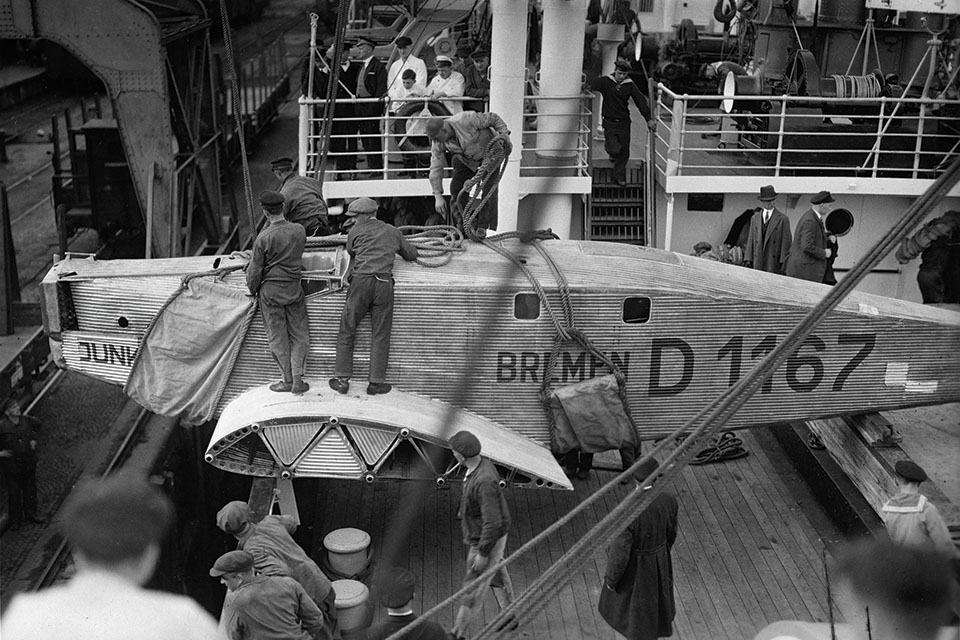
Promoted to colonel in July 1928, Fitzmaurice resigned from the air corps in February 1929. Disappointed by the lack of interest in civil aviation in Ireland, he returned to the social whirl of Manhattan, a move that ultimately led to his wife divorcing him. Fitz was in England in August 1933 when the Royal Aero Club granted him pilot’s certificate No. 11324. Intriguingly, he gave his nationality then as “British,” perhaps a sign of his disenchantment with Ireland over his unsuccessful attempts to promote aviation there.
In May 1934, Fitz sought authorization from U.S. officials to export an American high-speed airplane to compete in the October 20 London-to-Melbourne MacRobertson Trophy Air Race. This was the Bellanca Flash 28-70 Irish Swoop, sponsored by the Irish Hospital Trusts and patriotically liveried with green wings, yellow cowling and white fuselage. Fitz’s copilot was to be ex-RAF sergeant Eric Bonar. Ultimately the Bellanca was disqualified at the last moment because it lacked certified approval for full-load landing tests. A seething Fitz then decided to beat the eventual winner’s time of 71 hours, setting off for Australia in the Bellanca with Bonar on October 29. They got no farther than Belgium before bolts shearing from the engine cowling and wheel shields breaking adrift forced them to turn back.
The Irish Swoop debacle marked the end of Fitz’s glory days, although he remained active in commercial aviation in the U.S. and was often in England. On a flight back to London from Paris in September 1936, poor visibility caused him to make an unscheduled landing in the grounds of Henry VIII’s old palace at Hampton Court. During World War II Fitzmaurice ran a servicemen’s club in London. When a postwar attempt at journalism in Ireland failed, he drifted into the role of forgotten and embittered hero. Almost blind, he suffered from poor health and lived in reduced circumstances. He died at age 67 in Dublin on September 26, 1965.
Belated recognition came with a state funeral and the unveiling of a memorial plaque on a hangar at Baldonnel. Many felt that Baldonnel itself should have been renamed in memory of Ireland’s most famous aviator, rather than after executed republican hero Roger Casement. But Fitz had served in the British military, and Irish memories are long.
RAF veteran and frequent contributor Derek O’Connor suggests for further reading Bremen, by Fred W. Hotson.
This feature originally appeared in the January 2010 issue of Aviation History. Subscribe here!

